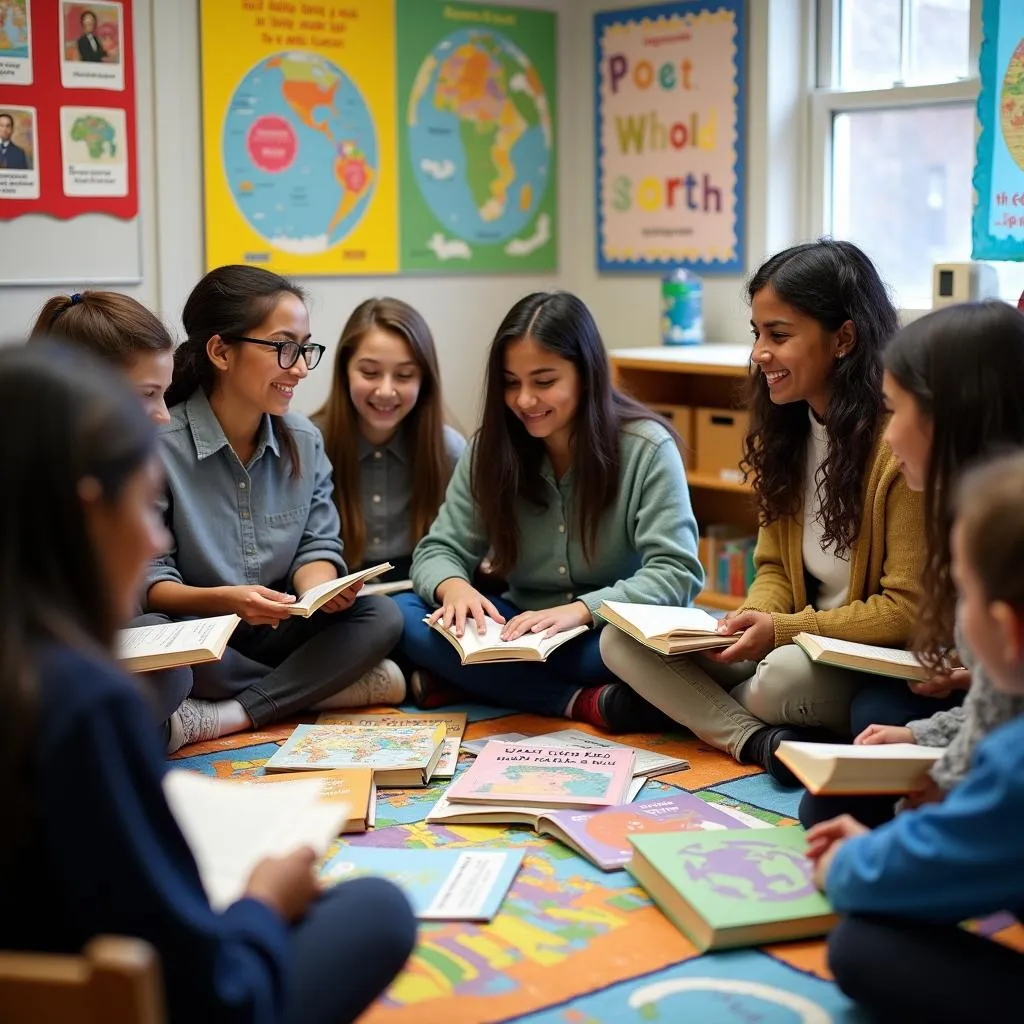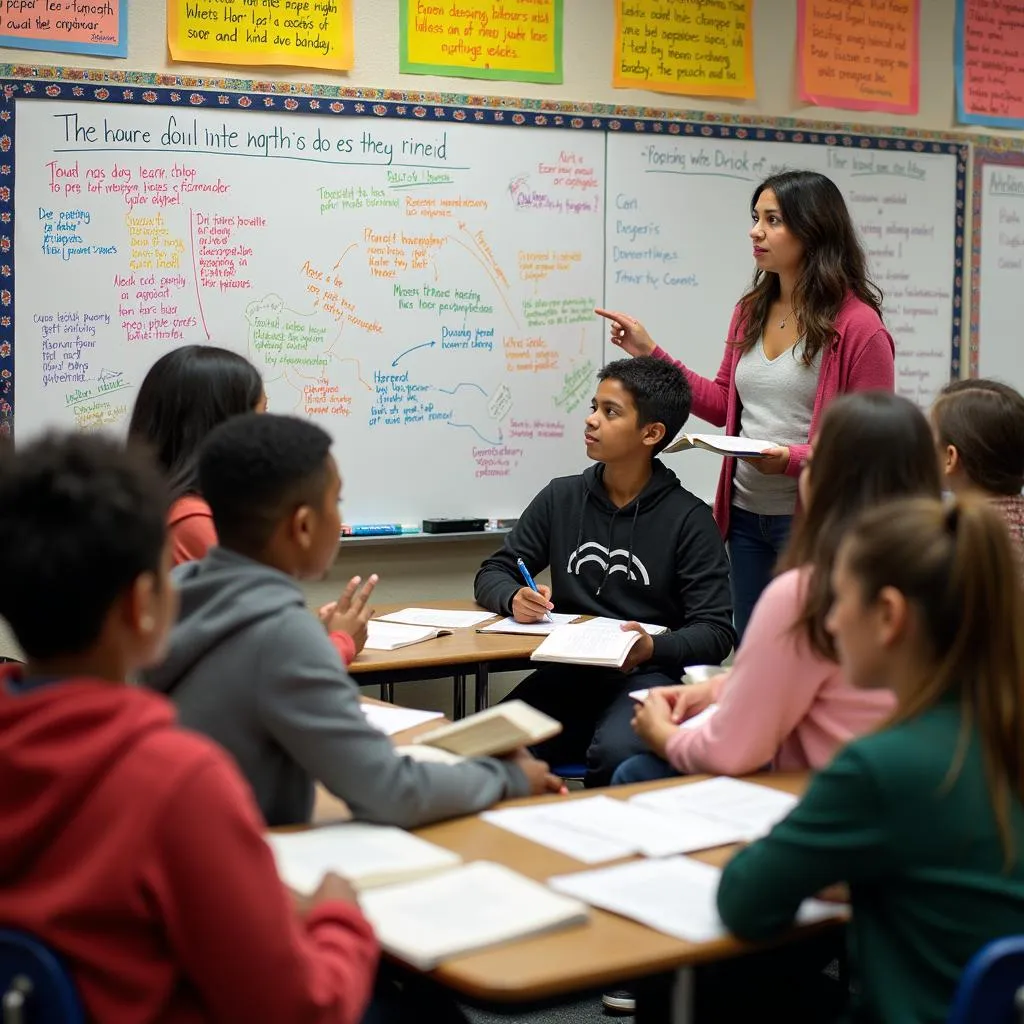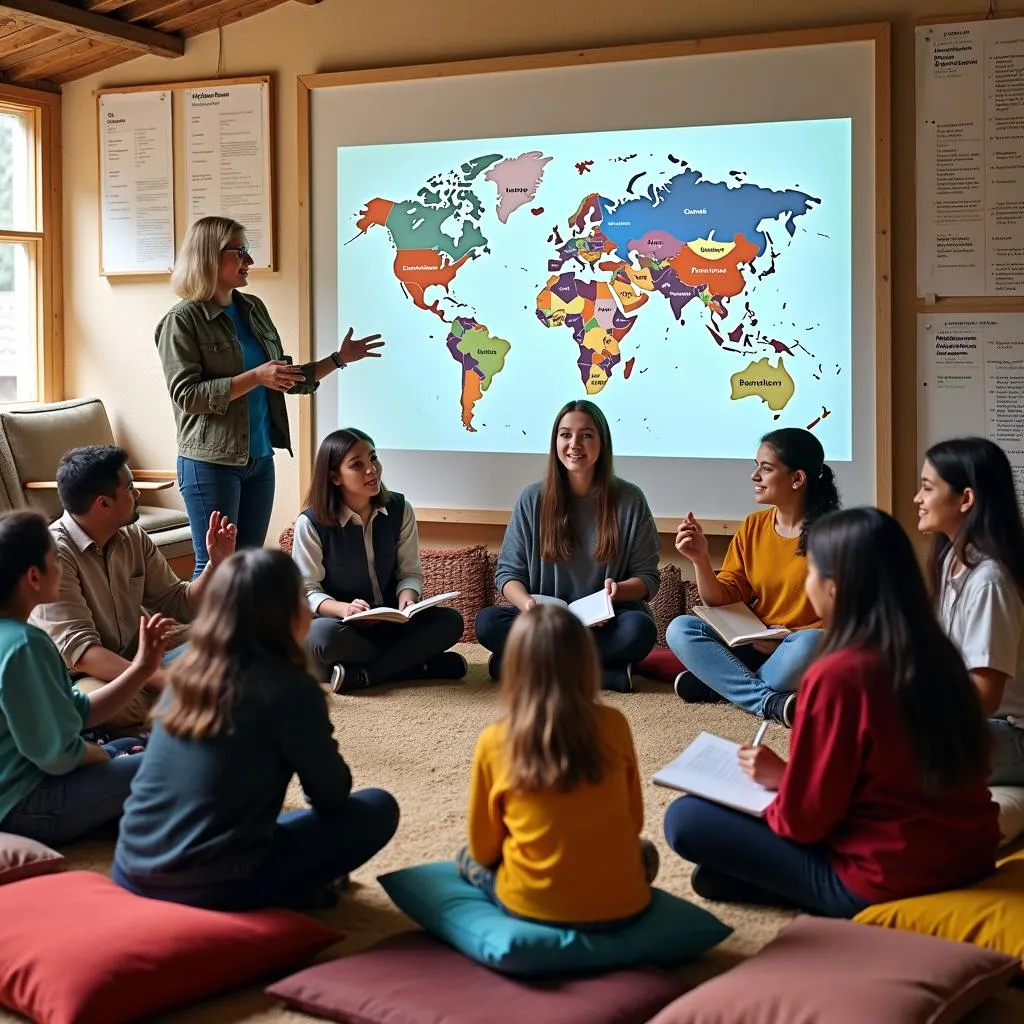Poetry has long been a powerful medium for expressing cultural diversity and identity. In this IELTS Reading practice, we’ll explore how poetry education reflects the rich tapestry of global cultures. Cultural influences on public speaking education can also be seen in the way poetry is taught and appreciated across different societies. Let’s dive into our IELTS Reading passages and questions to enhance your skills while exploring this fascinating topic.
Passage 1 (Easy Text)
The Global Poetic Tapestry
Poetry, often described as the language of the soul, has been a cornerstone of cultural expression for centuries. Across the globe, diverse communities use verse to convey their unique perspectives, traditions, and experiences. In recent years, there has been a growing recognition of the importance of inclusive poetry education that reflects the multifaceted nature of our global society.
Many educational institutions are now embracing a more diverse curriculum that includes works from poets of various cultural backgrounds. This shift is not only enriching students’ literary experiences but also fostering greater cross-cultural understanding. By studying poems from different parts of the world, learners gain insights into the nuances of language, imagery, and themes that are specific to various cultures.
For instance, haiku, a form of Japanese poetry, introduces students to the concept of capturing a moment in nature with brevity and precision. Meanwhile, the study of African praise poetry exposes learners to the oral traditions and rhythmic patterns that are integral to many African cultures. In the Americas, the works of indigenous poets offer a window into the struggles, triumphs, and worldviews of native communities.
This inclusive approach to poetry education is not without its challenges. Educators must navigate the complexities of translating works from their original languages while preserving their cultural essence. Additionally, there’s the task of contextualizing poems within their historical and social frameworks to ensure students fully grasp their significance.
Despite these hurdles, the benefits of a culturally diverse poetry curriculum are manifold. Students develop a broader perspective on the world, enhance their empathy, and cultivate a deeper appreciation for the power of language. Moreover, this approach validates the experiences of students from various backgrounds, making the classroom a more inclusive space.
As we move forward, it is clear that poetry education will continue to evolve, reflecting the ever-changing landscape of our global society. By embracing the works of poets from all corners of the world, we not only enrich our literary knowledge but also contribute to a more understanding and interconnected world.
 Global poetry education reflecting cultural diversity
Global poetry education reflecting cultural diversity
Questions 1-7
Do the following statements agree with the information given in the reading passage?
Write:
TRUE if the statement agrees with the information
FALSE if the statement contradicts the information
NOT GIVEN if there is no information on this
- Poetry has been used for cultural expression for many years.
- All educational institutions have fully adopted a diverse poetry curriculum.
- Studying poems from different cultures helps students understand various linguistic and thematic elements.
- Haiku is a form of Chinese poetry.
- Translating poems from their original languages is a simple task for educators.
- A culturally diverse poetry curriculum can make classrooms more inclusive.
- The article suggests that poetry education will remain unchanged in the future.
Questions 8-10
Complete the sentences below.
Choose NO MORE THAN THREE WORDS from the passage for each answer.
- African praise poetry introduces students to __ and rhythmic patterns.
- The works of __ poets provide insight into native communities in the Americas.
- Educators face the challenge of __ poems within their historical and social contexts.
Passage 2 (Medium Text)
The Renaissance of Multicultural Poetry in Education
The landscape of poetry education has undergone a significant transformation in recent decades, marking a renaissance in the way diverse cultural voices are represented and celebrated in classrooms worldwide. This shift reflects a broader societal movement towards recognizing and valuing the rich tapestry of global cultures, and the vital role that literature plays in fostering cross-cultural understanding and empathy.
Historically, poetry curricula in many countries were dominated by works from a narrow cultural or linguistic tradition, often reflecting colonial legacies or nationalistic agendas. However, the late 20th and early 21st centuries have seen a concerted effort to diversify these curricula, introducing students to a wider range of poetic traditions and contemporary voices.
This diversification has been driven by several factors. First, there’s been an increased awareness of the importance of representation in education. Students from diverse backgrounds are more likely to engage with literature when they see their own cultures and experiences reflected in the texts they study. Second, globalization and digital technology have made it easier than ever to access and share poetry from around the world, breaking down geographical and linguistic barriers.
The impact of this multicultural approach to poetry education has been profound. Students are now exposed to a variety of poetic forms, from Japanese haiku to Arabic qasidas, West African praise songs to Native American oral traditions. This exposure not only broadens their literary horizons but also challenges them to think critically about different cultural perspectives and ways of expressing human experiences.
Moreover, the study of multicultural poetry serves as a powerful tool for developing intercultural competence. By engaging with poems that emerge from diverse cultural contexts, students learn to navigate and appreciate differences in worldviews, values, and artistic expressions. This skill is increasingly valuable in our interconnected global society.
Educators implementing multicultural poetry curricula face several challenges. One is the need for contextual knowledge to effectively teach poems from unfamiliar cultures. This often requires additional research and professional development. Another challenge is balancing the representation of various cultures while still providing depth of study in each tradition.
Despite these challenges, the benefits of a multicultural approach to poetry education are clear. It fosters empathy, critical thinking, and a more nuanced understanding of the world. It also prepares students to be global citizens, capable of appreciating and engaging with diverse perspectives.
As we look to the future, the trend towards more inclusive and diverse poetry education is likely to continue. Emerging technologies, such as virtual reality and augmented reality, may offer new ways to immerse students in the cultural contexts of poems. Additionally, there’s growing interest in collaborative international projects that bring together students from different countries to share and explore each other’s poetic traditions.
The renaissance of multicultural poetry in education represents a significant step towards creating more inclusive and globally aware learning environments. By celebrating the diversity of poetic voices, we not only enrich our students’ literary experiences but also contribute to building a more understanding and interconnected world.
 Students discussing multicultural poetry in a classroom
Students discussing multicultural poetry in a classroom
Questions 11-16
Choose the correct letter, A, B, C, or D.
-
The transformation in poetry education reflects:
A) A focus on nationalistic agendas
B) A movement towards cultural diversity
C) A return to colonial traditions
D) An emphasis on a single cultural voice -
According to the passage, poetry curricula in the past were often:
A) Highly diverse and inclusive
B) Focused on global perspectives
C) Limited to specific cultural traditions
D) Regularly updated and modernized -
The diversification of poetry curricula has been facilitated by:
A) Stricter educational policies
B) Decreased global communication
C) Resistance from traditional educators
D) Advancements in digital technology -
Studying multicultural poetry helps students develop:
A) Intercultural competence
B) Nationalistic pride
C) Linguistic uniformity
D) Mathematical skills -
One of the challenges faced by educators in teaching multicultural poetry is:
A) Lack of student interest
B) Shortage of poetic material
C) Need for contextual knowledge
D) Overabundance of teaching resources -
The passage suggests that in the future, poetry education may involve:
A) Returning to traditional teaching methods
B) Focusing solely on local poetic traditions
C) Using virtual reality technologies
D) Eliminating poetry from the curriculum
Questions 17-20
Complete the summary below.
Choose NO MORE THAN TWO WORDS from the passage for each answer.
The renaissance of multicultural poetry in education represents a significant shift towards creating more inclusive learning environments. This approach exposes students to various poetic forms, from Japanese haiku to Arabic qasidas, helping them develop (17) __ and appreciate different cultural perspectives. While educators face challenges such as the need for (18) __ to teach unfamiliar poems effectively, the benefits are clear. Multicultural poetry education fosters empathy, critical thinking, and prepares students to be (19) __. Looking ahead, emerging technologies and (20) __ may offer new ways to explore diverse poetic traditions.
Passage 3 (Hard Text)
The Poetics of Cultural Confluence: Reimagining Education through Verse
The intersection of poetry and cultural diversity in educational settings has emerged as a potent catalyst for reimagining pedagogical approaches in the 21st century. This convergence not only enriches the literary landscape but also serves as a conduit for fostering intercultural understanding, challenging entrenched perspectives, and nurturing a more nuanced appreciation of global narratives. As educational institutions grapple with the imperative to prepare students for an increasingly interconnected world, the integration of diverse poetic traditions into curricula has become a locus of innovation and critical inquiry.
The traditional Western canon, long the cornerstone of poetry education in many parts of the world, is undergoing a significant transformation. This shift is not merely an additive process of including token representations from various cultures, but rather a fundamental reevaluation of what constitutes poetic excellence and cultural significance. Scholars and educators are increasingly recognizing the intrinsic value of poetic traditions that have been historically marginalized or overlooked, from the oral poetries of indigenous cultures to the avant-garde experiments of postcolonial writers.
This paradigm shift in poetry education is underpinned by a complex interplay of sociocultural factors. The global diaspora has led to the creation of multicultural societies where diverse poetic traditions coexist and cross-pollinate, giving rise to new hybrid forms of expression. Concurrently, the digital revolution has democratized access to a vast array of poetic works, enabling students and educators alike to engage with voices from across the globe with unprecedented ease.
The pedagogical implications of this cultural confluence in poetry education are profound and multifaceted. At its core, this approach challenges students to develop a more sophisticated understanding of language itself. By engaging with poems that emerge from diverse linguistic and cultural contexts, learners are compelled to grapple with the nuances of translation, the untranslatability of certain concepts, and the ways in which language shapes and is shaped by cultural worldviews.
Moreover, the study of culturally diverse poetry serves as a powerful tool for developing critical literacy skills. Students learn to interrogate the cultural assumptions embedded in texts, to recognize the interplay between form and content, and to appreciate the sociopolitical contexts that inform poetic production. This critical engagement extends beyond the realm of literature, equipping students with the analytical tools to navigate the complex cultural landscapes of our globalized world.
The implementation of a culturally diverse poetry curriculum, however, is not without its challenges. Educators must navigate the delicate balance between celebrating cultural diversity and avoiding the pitfalls of exoticization or superficial multiculturalism. This requires a commitment to ongoing professional development, as teachers must continually expand their own cultural competencies and literary knowledge.
Furthermore, the assessment of student engagement with diverse poetic traditions poses unique challenges. Traditional modes of literary analysis may prove inadequate when applied to works that emerge from fundamentally different cultural paradigms. As such, there is a growing need for innovative assessment strategies that can capture the nuanced understanding and cross-cultural competencies that this approach aims to foster.
Despite these challenges, the potential benefits of a culturally diverse approach to poetry education are manifold. Beyond enhancing literary appreciation, this pedagogical shift has the power to cultivate empathy, challenge ethnocentric perspectives, and prepare students for meaningful engagement in a pluralistic global society. It also has the potential to validate the experiences of students from diverse backgrounds, fostering a more inclusive educational environment.
As we look to the future, the evolution of poetry education towards greater cultural inclusivity is likely to accelerate. Emerging technologies, such as virtual reality and artificial intelligence, may offer new avenues for immersive cross-cultural poetic experiences. Additionally, there is growing interest in collaborative international projects that bring together students and poets from different cultural backgrounds, fostering real-time cultural exchange and creative collaboration.
In conclusion, the reimagining of poetry education through the lens of cultural diversity represents a significant paradigm shift in literary pedagogy. By embracing the rich tapestry of global poetic traditions, educators have the opportunity to not only enrich students’ literary experiences but also to cultivate the intercultural competencies essential for navigating our increasingly interconnected world. As this field continues to evolve, it holds the promise of fostering a more nuanced, empathetic, and globally aware generation of learners.
 Cultural diversity poetry workshop in action
Cultural diversity poetry workshop in action
Questions 21-26
Complete the summary below.
Choose NO MORE THAN TWO WORDS from the passage for each answer.
The integration of diverse poetic traditions into educational curricula has become a (21) __ of innovation in the 21st century. This shift involves a reevaluation of what constitutes poetic excellence and cultural significance, recognizing the (22) __ of historically marginalized traditions. The global diaspora and digital revolution have contributed to this change, enabling engagement with a wide array of poetic voices. This approach challenges students to develop a sophisticated understanding of language, including the concept of (23) __ for certain cultural ideas. However, educators must be careful to avoid (24) __ when implementing diverse poetry curricula. The potential benefits include fostering empathy and preparing students for engagement in a (25) __ society. Future developments may include the use of (26) __ for immersive cross-cultural poetic experiences.
Questions 27-30
Choose FOUR letters, A-H.
Which FOUR of the following are mentioned in the passage as challenges or considerations when implementing a culturally diverse poetry curriculum?
A) Lack of student interest in poetry
B) Balancing celebration of diversity with avoiding superficial representations
C) Limited availability of diverse poetic texts
D) Need for ongoing professional development for educators
E) Resistance from traditionalist academic circles
F) Developing new assessment strategies for cross-cultural competencies
G) High costs associated with curriculum changes
H) Difficulty in translating poems accurately
Questions 31-35
Do the following statements agree with the claims of the writer in the reading passage?
Write:
YES if the statement agrees with the claims of the writer
NO if the statement contradicts the claims of the writer
NOT GIVEN if it is impossible to say what the writer thinks about this
- The Western canon of poetry is being completely replaced by diverse cultural traditions in modern curricula.
- The digital revolution has made it more difficult for students to access diverse poetic works.
- Studying culturally diverse poetry can help students develop critical literacy skills.
- Traditional methods of literary analysis are always sufficient for assessing student engagement with diverse poetic traditions.
- The future of poetry education is likely to include more collaborative international projects.
Questions 36-40
Complete the sentences below.
Choose NO MORE THAN THREE WORDS from the passage for each answer.
- The integration of diverse poetic traditions serves as a __ for fostering intercultural understanding.
- The shift in poetry education is not just about including __ from various cultures.
- Engaging with poems from diverse contexts compels learners to grapple with the nuances of __.
- Educators must continually expand their own __ and literary knowledge.
- The reimagining of poetry education through cultural diversity represents a significant __ in literary pedagogy.
Answer Key
Passage 1
- TRUE
- FALSE
- TRUE
- FALSE
- FALSE
- TRUE
- FALSE
- oral traditions
- indigenous
- contextualizing
Passage 2
- B
- C
- D
- A
- C
- C
- critical thinking
- contextual knowledge
- global citizens
- collaborative international projects
Passage 3
-
locus
-
intrinsic value
-
untranslatability
-
exoticization
-
pluralistic
-
virtual reality
-
B, D, F, H
-
NO
-
NO


